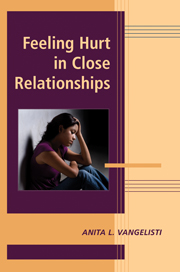Book contents
1 - Hurt Feelings: Distinguishing Features, Functions, and Overview
from PART I - INTRODUCTION
Published online by Cambridge University Press: 04 August 2010
Summary
Hurt feelings are powerful. They can influence relational partners' behavior, the thoughts that partners have about their relationship, and the attitudes they hold toward each other. Over time, the way people interpret and respond to their hurt feelings can affect the decisions they make about initiating, maintaining, and terminating relationships. Some who have been hurt repeatedly opt to avoid close relationships altogether, whereas others anxiously search for a partner who will shield them from emotional pain. Yet others find ways to cope with their experiences that enable them to initiate and maintain relatively secure, satisfying partnerships.
Given the potential influence of hurt feelings on people's close relationships, it is not surprising that researchers and theorists have begun to turn their attention to understanding the antecedents, processes, and outcomes associated with the emotion. Indeed, the study of hurt feelings has flourished over the past decade. Scholars have examined issues such as the phenomenology of hurt (Leary, Springer, Negel, Ansell, & Evans, 1998), the perceived causes of hurt feelings (Vangelisti, Young, Carpenter, & Alexander, 2005), the influence of intentionality on hurt (Vangelisti & Young, 2000), factors that affect the way people evaluate hurtful communication (Young, 2004), distancing responses to hurt (McLaren & Solomon, 2008), the effects of hurtful events on romantic relationships (Feeney, 2004), individuals' willingness to confront hurtful messages from romantic partners (Miller & Roloff, 2005), parent and child perceptions of hurtful interactions (Mills, Nazar, & Farrell, 2002), and hurtful family environments (Vangelisti, Maguire, Alexander, & Clark, 2007).
- Type
- Chapter
- Information
- Feeling Hurt in Close Relationships , pp. 3 - 12Publisher: Cambridge University PressPrint publication year: 2009
References
- 4
- Cited by

